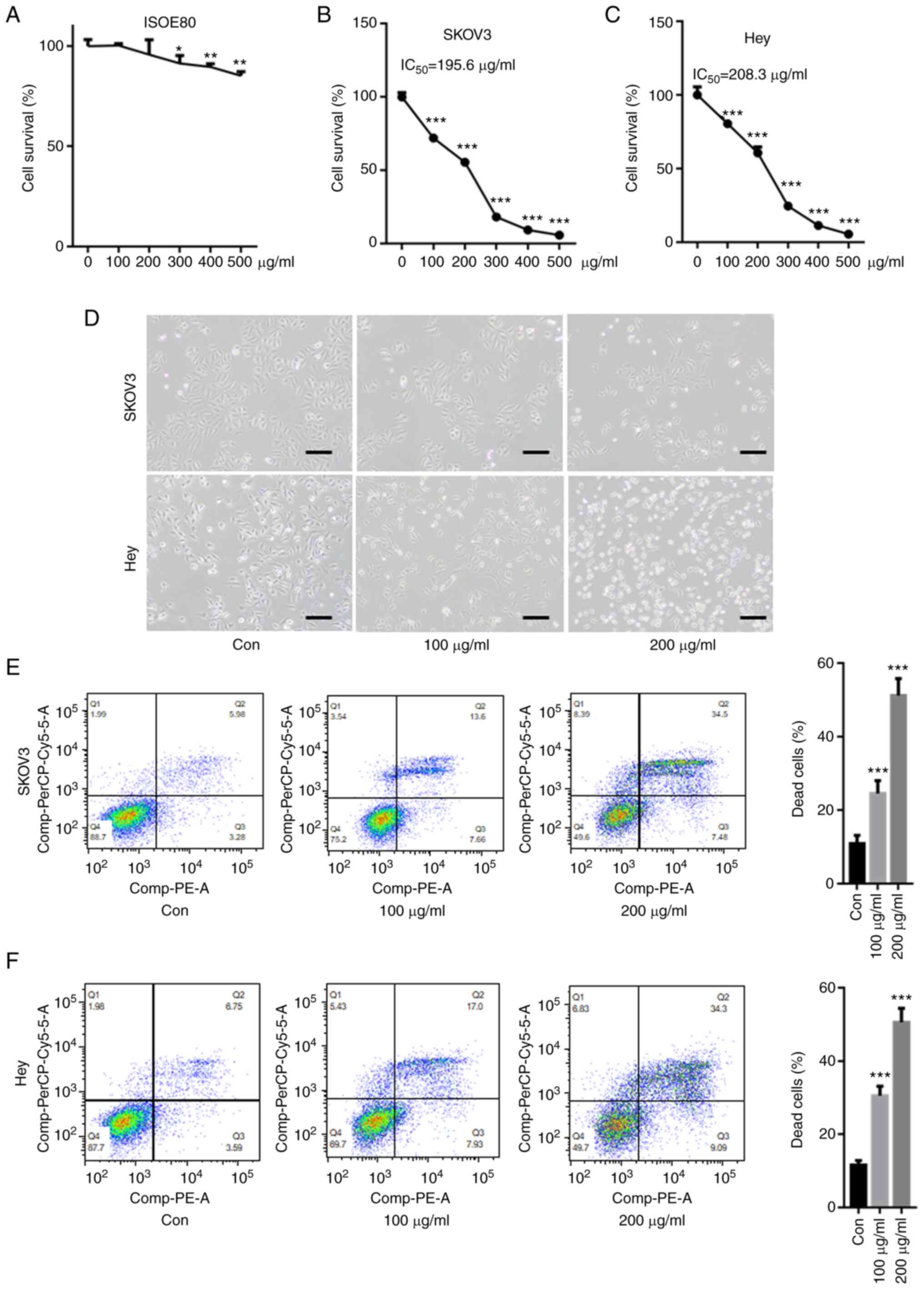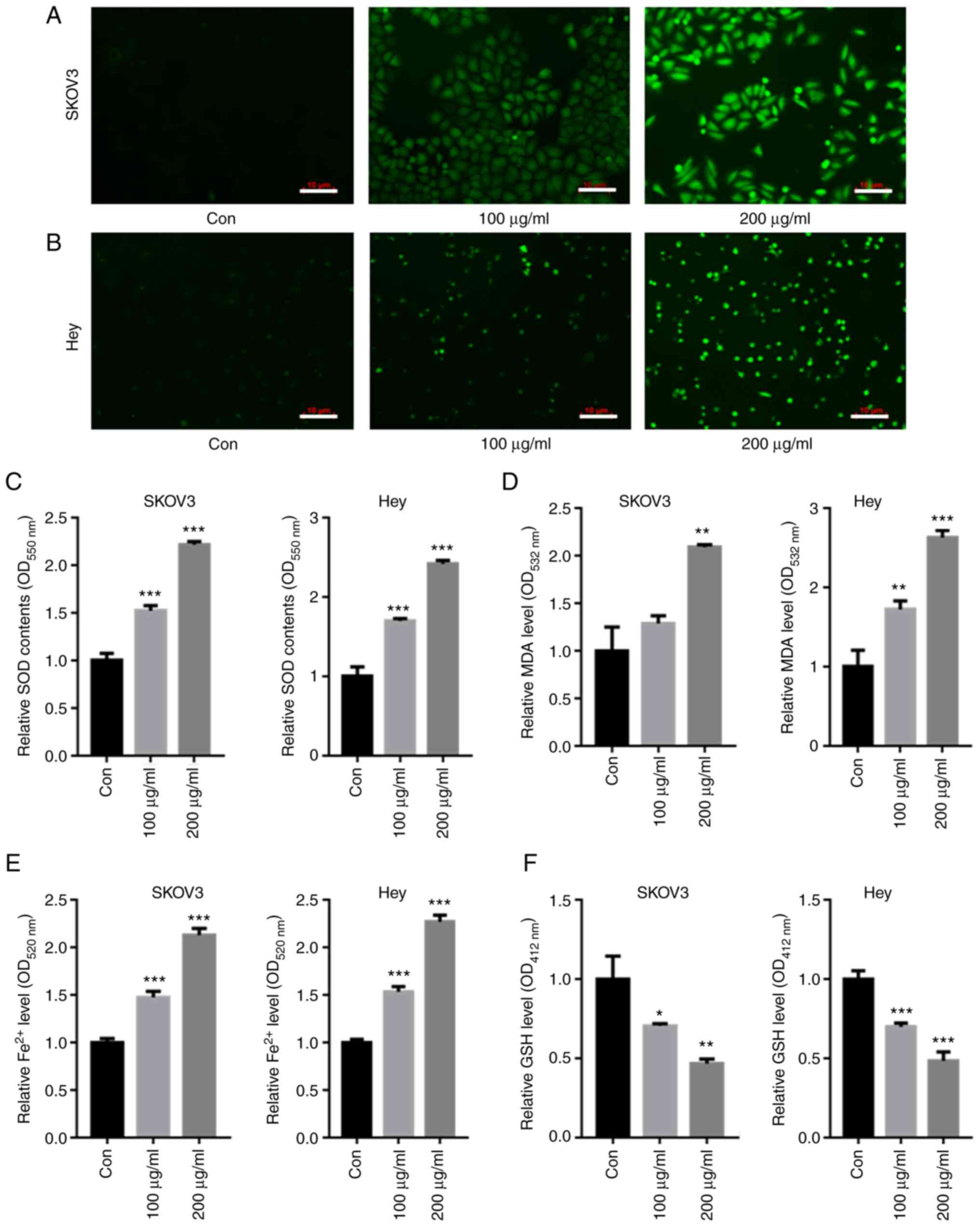|
1
|
Wang Y and Zhu Z: Oridonin inhibits
metastasis of human ovarian cancer cells by suppressing the mTOR
pathway. Arch Med Sci. 15:1017–1027. 2019. View Article : Google Scholar : PubMed/NCBI
|
|
2
|
Yang C, Xia BR, Zhang ZC, Zhang YJ, Lou G
and Jin WL: Immunotherapy for ovarian cancer: Adjuvant,
combination, and neoadjuvant. Front Immunol. 11:5778692020.
View Article : Google Scholar : PubMed/NCBI
|
|
3
|
Doubeni CA, Doubeni AR and Myers AE:
Diagnosis and management of ovarian cancer. Am Fam Physician.
93:937–944. 2016.PubMed/NCBI
|
|
4
|
Achatz MI, Caleffi M, Guindalini R,
Marques RM, Nogueira-Rodrigues A and Ashton-Prolla P:
Recommendations for advancing the diagnosis and management of
hereditary breast and ovarian cancer in Brazil. JCO Glob Oncol.
6:439–452. 2020. View Article : Google Scholar : PubMed/NCBI
|
|
5
|
Jafari M, Hasanzadeh M, Solhi E,
Hassanpour S, Shadjou N, Mokhtarzadeh A, Jouyban A and Mahboob S:
Ultrasensitive bioassay of epitope of Mucin-16 protein (CA 125) in
human plasma samples using a novel immunoassay based on silver
conductive nano-ink: A new platform in early stage diagnosis of
ovarian cancer and efficient management. Int J Biol Macromol.
126:1255–1265. 2019. View Article : Google Scholar : PubMed/NCBI
|
|
6
|
Johnson C and Jazaeri AA: Diagnosis and
management of immune checkpoint inhibitor-related toxicities in
ovarian cancer: A series of case vignettes. Clin Ther. 40:389–394.
2018. View Article : Google Scholar : PubMed/NCBI
|
|
7
|
Jayson GC, Kohn EC, Kitchener HC and
Ledermann JA: Ovarian cancer. Lancet. 384:1376–1388. 2014.
View Article : Google Scholar : PubMed/NCBI
|
|
8
|
Sun Y, Chen P, Zhai B, Zhang M, Xiang Y,
Fang J, Xu S, Gao Y, Chen X, Sui X and Li G: The emerging role of
ferroptosis in inflammation. Biomed Pharmacother. 127:1101082020.
View Article : Google Scholar : PubMed/NCBI
|
|
9
|
Dodson M, Castro-Portuguez R and Zhang DD:
NRF2 plays a critical role in mitigating lipid peroxidation and
ferroptosis. Redox Biol. 23:1011072019. View Article : Google Scholar : PubMed/NCBI
|
|
10
|
Zhang H, Yuan B, Huang H, Qu S, Yang S and
Zeng Z: Gastrodin induced HO-1 and Nrf2 up-regulation to alleviate
H2O2-induced oxidative stress in mouse liver
sinusoidal endothelial cells through p38 MAPK phosphorylation. Braz
J Med Biol Res. 51:e74392018. View Article : Google Scholar : PubMed/NCBI
|
|
11
|
Fan Z, Wirth AK, Chen D, Wruck CJ, Rauh M,
Buchfelder M and Savaskan N: Nrf2-Keap1 pathway promotes cell
proliferation and diminishes ferroptosis. Oncogenesis. 6:e3712017.
View Article : Google Scholar : PubMed/NCBI
|
|
12
|
Li B, Nasser MI, Masood M, Adlat S, Huang
Y, Yang B, Luo C and Jiang N: Efficiency of traditional Chinese
medicine targeting the Nrf2/HO-1 signaling pathway. Biomed
Pharmacother. 126:1100742020. View Article : Google Scholar : PubMed/NCBI
|
|
13
|
Chen D, Fan Z, Rauh M, Buchfelder M,
Eyupoglu IY and Savaskan N: ATF4 promotes angiogenesis and neuronal
cell death and confers ferroptosis in a xCT-dependent manner.
Oncogene. 36:5593–5608. 2017. View Article : Google Scholar : PubMed/NCBI
|
|
14
|
Lee N, Carlisle AE, Peppers A, Park SJ,
Doshi MB, Spears ME and Kim D: xCT-Driven expression of GPX4
determines sensitivity of breast cancer cells to ferroptosis
inducers. Antioxidants (Basel). 10:3172021. View Article : Google Scholar : PubMed/NCBI
|
|
15
|
Wang C, Huo X, Gao L, Sun G and Li C:
Hepatoprotective effect of carboxymethyl pachyman in
fluorouracil-treated CT26-bearing mice. Molecules. 22:7562017.
View Article : Google Scholar : PubMed/NCBI
|
|
16
|
Wang C, Yang S, Gao L, Wang L and Cao L:
Carboxymethyl pachyman (CMP) reduces intestinal mucositis and
regulates the intestinal microflora in 5-fluorouracil-treated CT26
tumour-bearing mice. Food Funct. 9:2695–2704. 2018. View Article : Google Scholar : PubMed/NCBI
|
|
17
|
Livak KJ and Schmittgen TD: Analysis of
relative gene expression data using real-time quantitative PCR and
the 2(−Delta Delta C(T)) method. Methods. 25:402–408. 2001.
View Article : Google Scholar : PubMed/NCBI
|
|
18
|
Qiang Z, Dong H, Xia Y, Chai D, Hu R and
Jiang H: Nrf2 and STAT3 alleviates ferroptosis-mediated IIR-ALI by
regulating SLC7A11. Oxid Med Cell Longev. 2020:51469822020.
View Article : Google Scholar : PubMed/NCBI
|
|
19
|
Carbone M and Melino G: Stearoyl Coa
desaturase regulates ferroptosis in ovarian cancer offering new
therapeutic perspectives. Cancer Res. 79:5149–5150. 2019.
View Article : Google Scholar : PubMed/NCBI
|
|
20
|
Zhu J, Xiong Y, Zhang Y, Wen J, Cai N,
Cheng K, Liang H and Zhang W: The molecular mechanisms of
regulating oxidative stress-induced ferroptosis and therapeutic
strategy in tumors. Oxid Med Cell Longev. 2020:88107852020.
View Article : Google Scholar : PubMed/NCBI
|
|
21
|
Oh YS and Jun HS: Effects of glucagon-like
peptide-1 on oxidative stress and Nrf2 Signaling. Int J Mol Sci.
19:262017. View Article : Google Scholar : PubMed/NCBI
|
|
22
|
Bellezza I, Giambanco I, Minelli A and
Donato R: Nrf2-Keap1 signaling in oxidative and reductive stress.
Biochim Biophys Acta Mol Cell Res. 1865:721–733. 2018. View Article : Google Scholar : PubMed/NCBI
|
|
23
|
Dong H, Qiang Z, Chai D, Peng J, Xia Y, Hu
R and Jiang H: Nrf2 inhibits ferroptosis and protects against acute
lung injury due to intestinal ischemia reperfusion via regulating
SLC7A11 and HO-1. Aging (Albany NY). 12:12943–12959. 2020.
View Article : Google Scholar : PubMed/NCBI
|
|
24
|
Song X and Long D: Nrf2 and Ferroptosis: A
new research direction for neurodegenerative diseases. Front
Neurosci. 14:2672020. View Article : Google Scholar : PubMed/NCBI
|
|
25
|
Deng HF, Yue LX, Wang NN, Zhou YQ, Zhou W,
Liu X, Ni YH, Huang CS, Qiu LZ, Liu H, et al: Mitochondrial iron
overload-mediated inhibition of Nrf2-HO-1/GPX4 Assisted ALI-induced
nephrotoxicity. Front Pharmacol. 11:6245292021. View Article : Google Scholar : PubMed/NCBI
|















